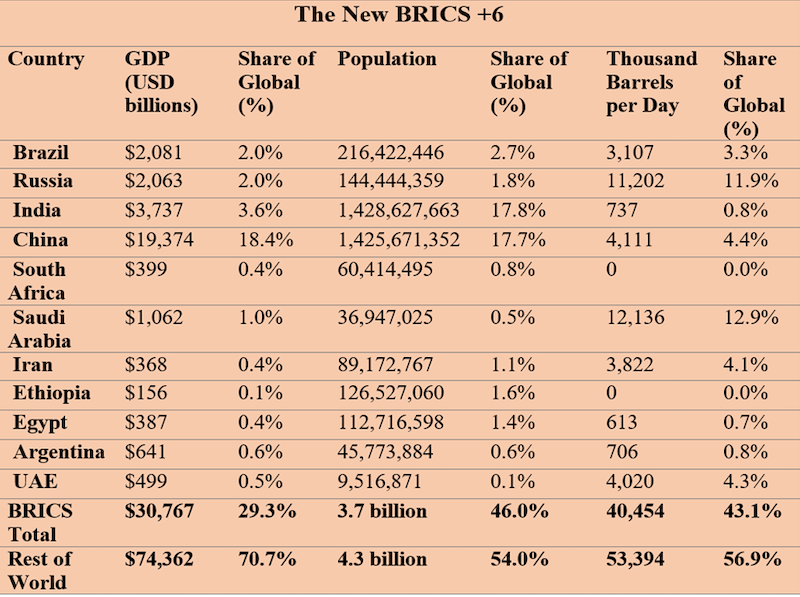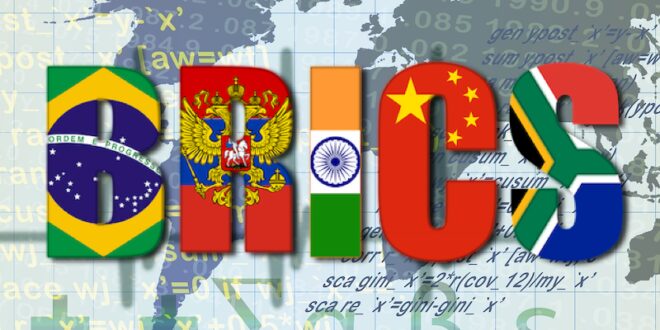The 15th BRICS meeting is a key landmark that marks a substantial change in the global economic landscape. This move is mostly related to the addition of new members, which represents a deviation from the alliance’s established principles. This development has inevitably raised concerns about its consequences for the global economy, especially in light of the current global economic crisis.
This new membership comprises both established countries and emerging economies. The announcement made on August 24, 2023, is very significant in this story of growth. This carefully selected group of new members represents a wide range of geographical areas and economic characteristics, emphasizing the alliance’s commitment to supporting a comprehensive and inclusive approach to global economic cooperation. These acquisitions demonstrate the BRICS association’s dynamic nature and flexibility to welcome and engage a varied variety of economic profiles.
BRICS itself is a collaborative assembly of five major countries—Brazil, Russia, India, China, and South Africa—united by their shared status as emerging economies. Beyond their economic affinities, this consortium is characterized by its concerted efforts to enhance diplomatic coordination, advocate for reforms within global financial institutions, and ultimately assert itself as a counterbalance to the prevailing Western hegemonic influence. This collective agenda seeks to reshape the dynamics of global economic and political interactions.

What does it mean for global economy?
Achieving Economic Enlargement through Inclusion
The decision to welcome new members into the BRICS alliance marks a substantial expansion of its economic prowess. Prior to their inclusion, the combined economic output of the BRICS nations stood at around $27 trillion. With the original six members projected to reach a combined GDP of $27.6 trillion in 2023, equivalent to 26.3% of the global total, the addition of these new nations pushes the anticipated GDP to approximately $30.8 trillion, granting them a 29.3% share of the global economy. This incorporation translates to an enhanced economic influence for the BRICS, demonstrating a significant shift in scale and potential impact on the global stage.
Diverse Regional Synergy
The inclusion of members from three continents emphasizes BRICS’ enduring relevance in the Arab and Latin American regions, offering increased economic prospects. Concurrently, Argentina’s membership strengthens economic collaboration in Latin America. The participation of Iran and Egypt reflects BRICS’ interest in fostering robust economic partnerships in the Middle East. Furthermore, the addition of Ethiopia underscores the alliance’s commitment to supporting the development of African nations and fostering economic growth across the continent.
Shifting Global Energy Landscape
The notable entry of Saudi Arabia and the UAE into BRICS holds significant implications for the global energy sector. Despite global efforts to transition away from fossil fuels, the substantial size of the global oil market remains undeniable. BRICS’ amplified involvement in this realm, primarily due to the inclusion of Saudi Arabia – responsible for 12.9% of global oil production – is noteworthy. Based on data from the Energy Institute Statistical Review of World Energy in 2022, BRICS’ share of global oil production is set to surge from 20.4% to 43.1%. This transformation carries the potential to reshape energy negotiations, impacting both the global economy and energy markets. Additionally, this united front may empower the alliance to collectively address energy-related policies, such as sanctions.
Enabling Economic Diplomacy in the Middle East
The integration of Middle Eastern economies, notably Iran and Saudi Arabia, holds substantial geopolitical and economic implications. These additions could serve as mediators for economic and political dialogues, facilitating smoother negotiations in regions marked by bilateral challenges. Moreover, this expansion opens doors for other Middle Eastern nations to potentially join BRICS, fostering heightened economic engagement across the region. Argentina’s accession is equally significant, injecting substantial economic strength into the BRICS alliance, benefiting both the collective and Argentina’s individual economic prospects.
Prioritizing Engagement in Africa and the Middle East
The inclusion of Egypt and Ethiopia into BRICS’ fold underscores the alliance’s unwavering commitment to integrating African nations into the global economic landscape. This strategic choice aligns with BRICS’ aim to counterbalance the influence of other regional actors while strengthening its own engagement. Moreover, BRICS’ concerted focus on African and Middle Eastern economies showcases its dedication to nurturing economic growth and stability in these regions, setting the stage for broader international collaboration.
Forging New Paths in Global Trade
The expansion of BRICS’ membership heralds the advent of innovative trade routes and collaborative endeavors. By integrating economies with distinct strengths, the alliance has substantially widened its economic reach. This expansion possesses the potential to invigorate economic progress by facilitating trade among member states and harnessing their diverse economic capabilities. As BRICS embarks on fresh trajectories within the global trade landscape, it positions itself as a dynamic force that is shaping the future of the worldwide economy.
BRICS’ Penetration into Vital Trade Routes – Suez, Hormuz, and the Horn of Africa
The incorporation of Egypt into BRICS’ ranks marks a pivotal moment in the alliance’s relationship with the Suez Canal, ushering in a new paradigm within the global economic terrain. Simultaneously, the linkage between Iran and the UAE signifies BRICS’ entrance into the geopolitically crucial Strait of Hormuz, a conduit that handles over half of the world’s energy supplies. Furthermore, the inclusion of Ethiopia as a BRICS member hints at the alliance’s future expansion potentially encompassing South Asia, the Middle East, and the broader Indo-Pacific region. This trajectory carries significant weight, as the Horn of Africa and the Red Sea corridor serve as pivotal gateways to the Indo-Pacific. This strategic maneuver appears to be a calculated response by BRICS to the ongoing shifts and consolidations within the Indo-Pacific region in recent times.
The Integration of Egypt: Pioneering Economic Ventures
The addition of Egypt to the roster of BRICS member states represents a substantial milestone, solidifying the alliance’s economic connections to the Suez Canal. This strategic step not only bolsters BRICS’ engagement with vital maritime trade routes but also reflects its broader economic aspirations. The Suez Canal, acting as a linchpin between the Mediterranean Sea and the Red Sea, plays a pivotal role in facilitating global trade and the movement of goods. By establishing strong ties with Egypt, BRICS is positioning itself to harness the economic advantages presented by the Suez Canal. This calculated move opens avenues for amplified trade and collaboration while positioning BRICS as a central player in the realm of global maritime commerce.
Navigating the Geopolitical Landscape: Hormuz and the Horn of Africa
The linkage between Iran and the UAE within the BRICS framework holds extensive implications, as it embarks on a journey into the intricate geopolitics of the Strait of Hormuz. This narrow passage, nestled between the Persian Gulf and the Gulf of Oman, has emerged as a geopolitical hotspot due to its role in facilitating a substantial portion of the world’s oil shipments. With its involvement in this region, BRICS steps into a domain where economic interests intersect with intricate political dynamics, necessitating a delicate equilibrium to ensure stability in the flow of energy resources and the safeguarding of global economic interests.
The entry of Ethiopia into the BRICS fold introduces another layer of strategic foresight. This move alludes to a potential expansion of BRICS’ influence into South Asia, the Middle East, and the broader Indo-Pacific region. The strategic significance of the Horn of Africa and the adjacent Red Sea corridor is twofold: it acts as a crucial gateway connecting the African continent to the Indo-Pacific and serves as a conduit for global maritime trade. As BRICS aligns itself with Ethiopia, it lays the groundwork for prospective economic and geopolitical engagements that extend further afield.
Countering the Realignment in the Indo-Pacific: BRICS’ Calculated Strategy
BRICS’ strategic calculus in extending its footprint to encompass vital trade routes and pivotal geopolitical intersections mirrors a concerted response to the evolving dynamics of the Indo-Pacific region. The recent push for greater integration in the Indo-Pacific underscores the strategic and economic importance attributed to this region by major global players. By broadening its reach to encompass the Horn of Africa and aligning with Ethiopia’s interests, BRICS positions itself as a counterweight to the burgeoning consolidation in the Indo-Pacific. This deliberate move seeks to establish BRICS as a relevant stakeholder not only in established global economic power centres but also in emerging domains that are shaping the trajectory of international commerce and geopolitics.
To summarise, the addition of new BRICS members has far-reaching repercussions for the global economic landscape. This strategic expansion brings together varied economies in a collaborative partnership that promises regional and global economic advantages. BRICS expansion is a purposeful endeavor to change the parameters of international economic cooperation, from changing energy dynamics to promoting diplomatic and commercial partnerships in difficult areas. The world will definitely be watching carefully as the BRICS alliance evolves with these additional members to see the degree of their combined impact on the global economy.
 Eurasia Press & News
Eurasia Press & News


